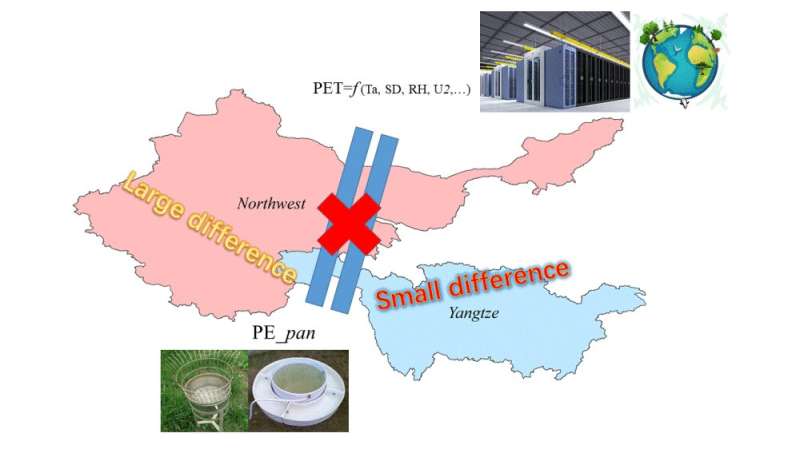Schematic diagram for the modeled PET deviation from PE_pan in the Northwest and Yangtze River basins. Credit: WANG Aihui
Potential evapotranspiration (PET), the amount of evaporation that would occur under certain meteorological conditions with a sufficient water supply, plays an important role in both energy and hydrological cycles at the land surface. It is usually calculated using empirical models based on surface meteorological variables, such as temperature, radiation and wind speed.
Various PET empirical models have been developed and used in both research and applications. But sometimes the in situ observed pan evaporation (PE) is also frequently used as a proxy for PET because PE can be measured at a meteorological station, and the measurement is obtained using an evaporation pan with enough water supply at an open site.
"Although many studies regard PE as a surrogate for PET, PET and PE have big differences in both magnitude and trend, especially in arid regions. Therefore, caution still should be taken when using the PET model in Northwest China," said Prof. Wang Aihui from the Institute of Atmospheric Physics (IAP) of the Chinese Academy of Sciences.
In her recently published study in Advances in Atmospheric Sciences, she set out to address two important issues about PET that remain unknown in China: Which is the most applicable model in each river basin in China? And how do variations of each surface meteorological variable influence the PET?
Prof. Wang and her graduate student XIE Ruiheng assessed the performance of 10 widely-used PET models with in situ observed PE data in China for the period 1961-2013.
In their study, the daily observed meteorological variables at 2,267 stations were used as the inputs to the models to compute the PET. The stations were divided into 10 different drainage basins, and comparisons and analyses were conducted in each basin.
They adopted a ranking scheme to synthetically assess the performance of each model by taking account of the ratio of standard deviations, correlation coefficient, and ratio of trends between the modeled and in situ PE in each drainage basin.
"Among all PET models, PETHam1 is the best model in the Pearl River basin, PETHam2 outperforms other models in the Huaihe, Yangtze River and Yellow River basins, and PETFAO is the best model for the remaining basins," said XIE.
Sensitivity analyses revealed that wind speed and sunshine duration were two important factors for decreasing PET in most basins except in Southeast and Southwest China. The increasing PET trend in Southeast China was mainly attributable to the reduced relative humidity.
"We hope that our study can provide a reference for selecting the most suitable PET model in each basin, as well as produce a long-term, high-quality daily PET dataset that can be used as a benchmark for PET relevant research in the future," said Prof. Wang.
More information: Ruiheng Xie et al. Comparison of Ten Potential Evapotranspiration Models and Their Attribution Analyses for Ten Chinese Drainage Basins, Advances in Atmospheric Sciences (2020). DOI: 10.1007/s00376-020-2105-0
Provided by Chinese Academy of Sciences
























